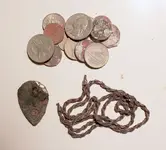1869er
Full Member
Went out again tonight for a little beach hunting... 4 hours flew by. Found the items listed below...
Pile of clad
Nice silver chain ~ 925 Italy
Mystery item? Needs to be cleaned.
A Dinner knife ~ handle might be silver or silver plated.
The old silver chain was nice to find... Broken clasp, probably from when it was lost.. Interesting designer marking, 925 Italy. Also a mystery item, guitar pick shaped, could be a badge of some sort, like from a bicycle... I chipped off an edge of the crustiness, not sure but it looks like it's plated with a shiny metal... It's probably junk, however.... What's the easiest way to do electrolysis to clean up items like this?? Can I just use salt in water and connect this item to the positive pole of say 9v dc?
Pile of clad
Nice silver chain ~ 925 Italy
Mystery item? Needs to be cleaned.
A Dinner knife ~ handle might be silver or silver plated.
The old silver chain was nice to find... Broken clasp, probably from when it was lost.. Interesting designer marking, 925 Italy. Also a mystery item, guitar pick shaped, could be a badge of some sort, like from a bicycle... I chipped off an edge of the crustiness, not sure but it looks like it's plated with a shiny metal... It's probably junk, however.... What's the easiest way to do electrolysis to clean up items like this?? Can I just use salt in water and connect this item to the positive pole of say 9v dc?
Attachments
Upvote
0




